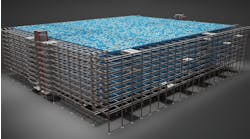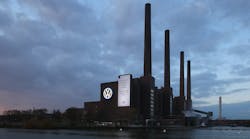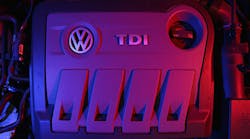Latest from Industry Trends
At Volkswagen, Engineering Change in the Eye of the Diesel Storm
In November 2014, the captains of Germany's auto industry gathered for an annual ceremony honoring the year's best cars in a 19th-floor private club with sweeping views of Berlin. As dozens of corporate A-listers gladhanded and sipped wine in the wood-paneled salon, Porsche chief Matthias Mueller received three Golden Steering Wheel awards--part of the Volkswagen Group's six-trophy haul. But the most valuable thing he may have picked up that evening was the business card of Thomas Sedran, an industry veteran and former head of General Motors in Europe.
After being appointed CEO of Volkswagen a year later, Mueller quickly rang up the consultant. The once-revered company had acknowledged rigging 11 million diesel vehicles to cheat on emissions tests, effectively putting profit before public health. Instead of a gleaming icon of German engineering, the company was reviled as a trickster that had besmirched the hallowed Made-in-Germany brand. As he sought to pull the company back from the brink, Mueller needed someone with a fresh perspective who could help him make tough decisions. Recalling Sedran's work in restructuring GM's European operations, which included closing a German factory and shutting down the Chevrolet brand in the region, he invited the consultant to Volkswagen's Wolfsburg headquarters for a chat.
For decades, there had been little upside to critical thinking in VW's corporate culture, and Mueller wanted an outsider who might give him an unvarnished view of the company. Meeting in the office of his discredited predecessor, Martin Winterkorn, Mueller found himself perched behind a baronial desk, a symbol of the prestige and power that felt dissonant with his push for more openness and cooperation. So he stepped around the massive wooden slab to meet Sedran eye-to-eye, sitting beside him in one of the modest visitor’s chairs.
Sedran outlined steps VW might take to absorb the blow from the scandal while still investing in the changes disrupting the industry. Less than a month later, Mueller hired Sedran for the newly created position of Strategy Chief, tasked with remapping the direction of a colossus with 620,000 workers, 121 factories, a dozen brands ranging from the budget Skoda to Lamborghini and Bugatti, and development spending that exceeds Apple Inc.'s.
“When Mueller called me, I thought ‘Awesome! What a chance,'” says Sedran, who has been asked to end inefficiencies like separate demand forecasts from the sales, purchasing, and finance departments. “My job is to step on a lot of people’s toes.”
VW needs some toe-stepping, or even stomping. Like all of its key rivals, the company must invest billions to adapt to the looming shift to electric cars and self-driving technology. But the VW brand, Volkswagen’s largest unit, is barely profitable. And unlike its competitors, Volkswagen faces criminal investigations, hundreds of lawsuits, and incalculable damage to its image due to the emissions cheating. So far, VW has set aside 18.2 billion euros ($19.5 billion) for fines and repairs, its market value has dropped by 13.5 billion euros, and its U.S. sales are off by 10 percent this year.
Overcoming the scandal involves more than paying off the damages and rolling out electric cars to clean up its image. Mueller, who has abandoned Winterkorn’s stately quarters in Volkswagen's landmark red-brick high rise for more humble digs next door, says the company must also redefine its rigid, top-down management and soften an atmosphere of fear.
“We need the courage to make mistakes,” he told staff and guests at the opening of a software lab in a loft-like space in Friedrichshain, a hipster neighborhood alongside the River Spree in the former East Berlin. “If we can combine the new world with the old, we’ll be successful.”
Putting an newcomer like Sedran in such a key position was an early sign of Mueller’s efforts to combine those worlds. Volkswagen has long been run by a small cadre of executives with ties going back decades, and its supervisory board is dominated by conservative power players: workers, the government of its home state of Lower Saxony, and the billionaire descendants of the creator of the original VW Beetle. The workers and Lower Saxony have a majority of seats on the board, and they typically vote together to ensure maximum employment.
To implement any real change at VW, “you need a lot of negotiations to ensure political support and the backing of labor,” says Juergen Pieper, an analyst at Bankhaus Metzler in Frankfurt who has covered Volkswagen for more than a decade. "All of this takes time” and limits the scope for reforms.
For a company built around mobility, VW is surprisingly static, weighed down by a record of success that never necessitated a deeper analysis of its byzantine structure. Its main Wolfsburg facility -- a jumble of manufacturing halls and office buildings that covers an area as big as Monaco -- was established by the Nazis in the 1930s to churn out a “people's car.” Its state backing and isolation from other German industrial centers contributed to an insular culture with its own set of rituals.
There are bizarre excesses like the so-called Service Factory -- a team of 3,400 caterers and custodians paid the same wages to serve sandwiches and sodas as line workers who assemble Golfs and Tiguans. There's an in-house butcher churning out more than 7 million sausages a year and a garden center where employees can order flowers. Its hometown of Wolfsburg boasts the Autostadt, a park-like tourist attraction that celebrates VW's history with a museum and pavilions for its various brands.
And there was an extreme deference to authority, with underlings exiting elevators to make way for top brass, and lunches in the executive dining room delivered under gleaming silver domes. Past Volkswagen bosses perpetuated the hierarchical structure. The gruff Winterkorn was detail-obsessed and micro-managed vehicle development. He was molded by his own boss, chairman and family patriarch Ferdinand Piech, a grandson of the Beetle's creator.
In an effort to loosen things up, Mueller and Sedran have curtailed the powers of the Product Strategy Committee, or PSK, a politburo that lorded over every aspect of development. Before the change, engineering, sales, and finance teams shared responsibility, and the inevitable disputes were settled by the PSK -- often by adding features sought by the engineers, leading to ballooning costs and complexity. Today, when a decision is made to add a new option, the manager in charge of the model line must ensure that it will generate enough money to justify the expense.
To streamline operations, Sedran pushed for Volkswagen to bundle together the group's sprawling component operations, which include about 70,000 workers at more than two dozen locations. While that ruffled feathers by threatening to take away lucrative parts business from some brands, it's aimed at finding savings across the group and ensuring there's money to invest in electric cars and services like ride-sharing.
“The burdens are enormous. We need discipline to stay the course,” Sedran says as he cracks a window to air out the smell of take-out Asian noodles from an office he borrowed from a colleague. To highlight his commitment to change, Sedran has shrugged off the trappings of status, which entitle executives to window space based on rank. Instead, for the past year, he’s been squatting in offices of co-workers when he's not at meetings or traveling.
Under Mueller, VW has instituted English as an official language, a small but notable change for a multinational that was often parochial in its worldview. Though the company has always had a native-German speaker as CEO, personnel chief Karlheinz Blessing, another newcomer, says that at the new VW even that barrier won't last forever.
“VW is active globally,” Blessing says. “Why shouldn't a first-class manager who doesn't come from Europe become CEO?”
A key area for reform will be labor costs. Volkswagen employs about 80 percent more people than Toyota to produce roughly the same number of vehicles. To rein in the job machine, VW in November reached a landmark labor deal, with the powerful workers' council agreeing to cut as many as 30,000 jobs, including 23,000 in Germany, and trim annual costs by 3.7 billion euros by 2020.
“The workforce is ready for change,” says Bernd Osterloh, Volkswagen’s long-standing works council chief. “We know things must be done differently, but it has to be fair.”
That's an acknowledgement that the shift to an era of electric-powered robo-taxis will mean fewer jobs for people churning out transmissions and engines, and more for software developers and cloud-computing experts. Volkswagen hasn't shown itself to be adept enough to deal with that kind of transition, but there are green shoots.
In a Wolfsburg building constructed for the development of the VW Phaeton -- a failed luxury sedan that embodied the company’s engineering hubris -- about 100 people are working on a car intended to counter the threat from Tesla as the U.S. upstart prepares its $35,000 Model 3, due next year. Volkswagen aims to sell as many as 3 million of them annually within a decade.
Inside the dull concrete structure, there’s the unexpected energy of a startup. Casually dressed staff zip around with laptops and handhelds, snaking through impromptu meetings in the narrow halls. The sales team has rigged a virtual-reality mock-up of a concept car called the I.D., presented at the Paris Motor Show in September. Instead of requisitioning a costly VR setup, which could have taken months, the marketers went to a local electronics store, bought a few headsets and fixed projectors to cubicle walls. The space where they can visualize design tweaks is marked off with orange tape in the middle of the office floor. The point is to do more with less, a stark departure from the days of almost unlimited budgets for development projects.
Heading the push is Christian Senger, another new recruit and an example of the revolution that’s sweeping through Volkswagen. Senger was a developer on BMW’s Project i, the luxury-car maker’s think tank that spawned the “i” electric-car sub-brand, then later went to parts supplier Continental AG where he worked on electronics systems.
Like Sedran, the 42-year-old has eschewed a private office, taking a desk in the corner of what looks like a public-school classroom. A dozen work stations salvaged from other facilities are arrayed along the windows, and the only privacy is a cramped meeting room wedged into the corner. A project chart with bright post-it notes lines one of the walls, while the others are dingy and unadorned, still awaiting wallpaper eight months after the team was given the space.
“If you want a parking spot with your name on it, you can look elsewhere,” Senger says before donning virtual-reality goggles to check out the concept car, which he dubs a “tablet on wheels.”
Ultimately, the challenge isn’t simply succeeding with a single high-profile project, but rather leveraging Volkswagen's enormous size while reining in complexity. Under Winterkorn, the automaker’s portfolio ballooned to more than 330 models. The Golf was burdened with 89 choices for the steering wheel and two dozen radiator grilles, and there were trim lines like “Shetland Beige” -- popular in Turkey but almost nowhere else. The company is starting to reduce some of that bloat, as the VW brand plans to eliminate about 15,000 parts variants and cut the number of prototypes of new cars by at least a third.
Still, Mueller hasn’t entirely stifled Volkswagen’s empire-building impulses, with the company expanding rather than retrenching since the emissions scandal erupted. In September, VW bought 16.6 percent of U.S. truckmaker Navistar International Corp., adding it to a commercial vehicles division that already includes Sweden's Scania and Germany's MAN as well as Volkswagen's heavy-truck operations in Latin America. That followed a $300 million investment in taxi-hailing app Gett. The investment kick-started a push to rival mobility services like Uber Technologies under a new division called Moia.
Sedran chairs an advisory committee for Berlin-based Moia, Volkswagen's 13th brand. He says the moves make sense as VW adapts to the auto industry’s new era, where driverless vehicles will be the norm, they run on batteries rather than gasoline, and more customers rely on sharing services or Uber-like ride-hailing instead of buying cars for their exclusive use.
“We’re undergoing three-dimensional change,” Sedran says. “In all areas, we’re making progress.”











